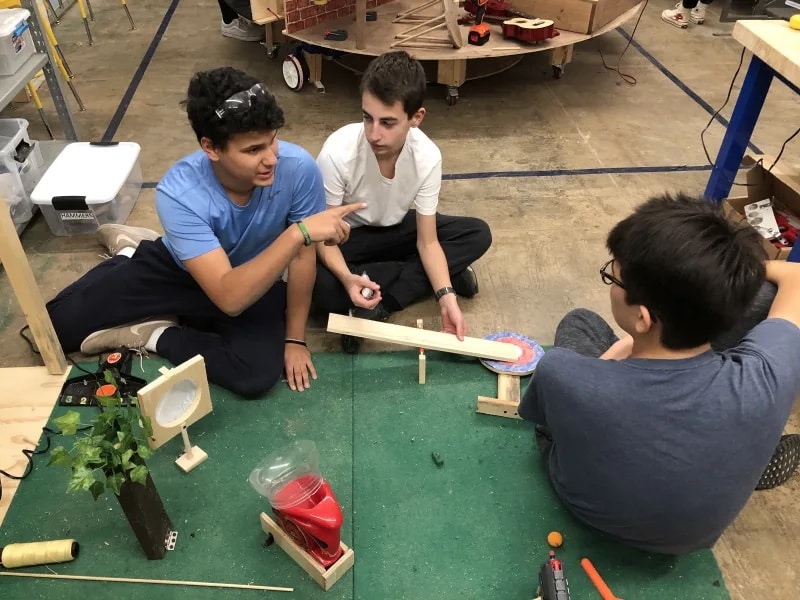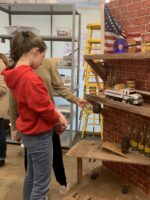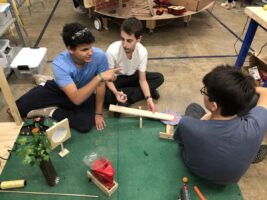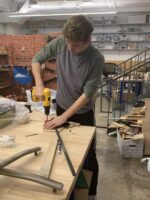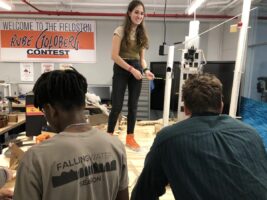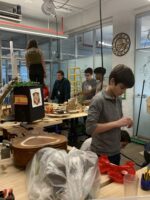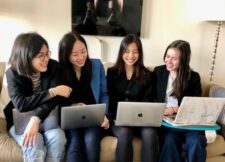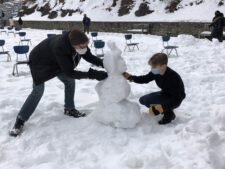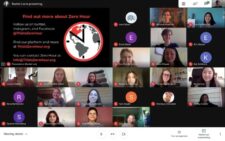If someone were to tell you that they were tinkering with the fifth energy transfer in their Rube Goldberg machine, you might first pause them to ask what on earth a Rube Goldberg machine is. The answer is, well, anything — as long as it’s complicated: A Rube Goldberg machine is any manner of contraption that uses a complex set of steps to complete a simple task. The most intricate Rube Goldberg machines involve multiple “energy transfers” — think of them as a chain reaction in which a rolling ball hits a pile of blocks that then collapses onto a seesaw, for example, or a falling weight presses a lever that then launches another object into motion.
These complicated devices are the perfect challenge to showcase the skills of the Ethical Culture Fieldston School’s Upper School Engineering Club, which is advised by Paul Church, Upper School Science Department Chair. For the fifth year in a row, ECFS hosted the Rube Goldberg Competition regionals, and the Form III team, combined Forms IV and V team, and Form VI teams all competed for a spot in the national competition.
So what goes into making a Rube Goldberg machine? In short: a ton of hard work, collaboration, and creativity.
At the beginning of the school year, students learned that their machines needed to turn off a light switch. Then began the ideation process: Each of ECFS’ three teams would need to come up with a story that the machine would tell.
The Form III team devised a theme based on the poem “The Night Before Christmas,” while the Form VI team took on the music world, covering country, classical, and disco. Meanwhile, the Forms IV and V team chose Around the World in 80 Days as their theme, with elements and landmarks from every continent.
“Energy transfers were related to the countries they sat upon,” explains Thomas V. ’22. “For example, the energy transfers over South America occurred in trees to symbolize the Amazon rainforest, and the energy transfers around the Northeast U.S. involved a taxi, the Empire State Building, and the Statue of Liberty.”
The Sunday of the regionals pitted the three Fieldston teams against each other and a team from a Long Island school — and even though the stakes were high, the feeling was of overwhelming support. Before the official runs took place, spectators milled about playing games (including a challenge to build the tallest tower using only uncooked spaghetti, tape, and marshmallows) and taking in the robots designed by Ethical Culture’s Robotics Club, who made the trip up to Riverdale for the event.
There was also a chance for the competitors to show off their machines to the judges before they officially competed — club members answered questions, pointed out design challenges, and even demonstrated full runs.
The teams’ scores were dependent on more than just the success of their runs. Their performances of their stories (which they recited before turning the machines on), their attention to the theme, and their overall spirit of collaboration were also up for scrutiny. “Teamwork is a big one,” says Sarah W. ’20. “The day of the competition, you can’t be fighting with your team. You literally get points if you’re hanging around talking because they judge you on every level. It encourages a community that we already have.”
As the time came for the official runs, the energy in the room escalated, says Jonah L. ’20. The anxiety mounted: “In each of the three years I’ve competed, it’s maybe the most nervous I’ve ever been in my life,” he says.
For the Form VI team, things unfortunately didn’t go as planned. After days of perfect runs, the machine hit a snag, and the team was dinged by the judging panel. It was a tough blow, especially since team members had placed first each of the previous three years. But they found a silver lining: The Form III team took first place and earned a ticket to the national competition. “It was our first year, and we were all glad that our machine was just able to work,” says Zachary G. ’23. “When we won, we were so happy. We could not believe that we won our first year.”
With the Form III team in first place, the Forms IV and V team in second, and the Form VI team in third, ECFS swept the podium. But it turns out it wasn’t over for the Form VI team: A representative of the national competition was bowled over by their machine, and offered them a wildcard spot at the nationals. The team was utterly thrilled.
In light of the COVID-19 crisis, the nationals didn’t happen in their usual form. Instead, teams submitted videos of their entire machine run, with a closeup of the slinky step. (This year’s contest was sponsored by Slinky, so each team used a metal coil in their contraption.) Of the three awards offered at the virtual nationals this year, ECFS brought home two: The Form III team won the Legacy Award and the Form VI team won Best Use of a Slinky.
But the work the Engineering Club does is about so much more than national titles and accolades, say club members. “You can really see that everyone genuinely loves doing the competition, and they really put their all into it,” says Max C. ’20, a founding member of the club.
The Rube Goldberg competition also provides an entry point for people less confident about science, says Daphne Z. ’20. “STEM sometimes is very right or wrong, or really focused on mechanics. Here, there is an emphasis on the science, but it also adds creativity and art and whole brain thinking that brings in a lot of people who wouldn’t necessarily be drawn to the sciences.”
It’s also been a way to connect, both within individual teams and across grade levels. “I know what the club has meant to all of us. I think we’ve all seen the benefits — we’ve all become really good friends with one another,” Daphne says. “We didn’t come in first, but another Fieldston team did, and it feels a little bit like passing on the baton. Being able to have another Fieldston team who we know is going to carry on the same meaning of the club is powerful.”
Students don’t receive any academic credit for the countless hours they put into their machines, points out Church, a testament to their true passion for their craft. Credit or not, the students spend every Tuesday afternoon and every Saturday morning in the recently renovated Design Studio — which the students mentioned was a significant boon to their work and allowed them to be more ambitious — on top of their other academic responsibilities.
“They’re all working together on this ridiculously complicated thing, and everyone relies on each other’s step,” Church says. “There’s no finger pointing, and no blaming — just complete support. The truth is that, throughout all of this, the mood really is joy.”
